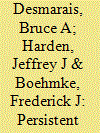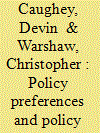|
|
|
Sort Order |
|
|
|
Items / Page
|
|
|
|
|
|
|
| Srl | Item |
| 1 |
ID:
140179


|
|
|
|
|
| Summary/Abstract |
The transmission of ideas, information, and resources forms the core of many issues studied in political science, including collective action, cooperation, and development. While these processes imply dynamic connections among political actors, researchers often cannot observe such interdependence. One example is public policy diffusion, which has long been a focus of multiple subfields. In the American state politics context, diffusion is commonly conceptualized as a dyadic process whereby states adopt policies (in part) because other states have adopted them. This implies a policy diffusion network connecting the states. Using a dataset of 187 policies, we introduce and apply an algorithm that infers this network from persistent diffusion patterns. The results contribute to knowledge on state policy diffusion in several respects. Additionally, in introducing network inference to political science, we provide scholars across the discipline with a general framework for empirically recovering the latent and dynamic interdependence among political actors.
|
|
|
|
|
|
|
|
|
|
|
|
|
|
|
|
| 2 |
ID:
159498


|
|
|
|
|
| Summary/Abstract |
Using eight decades of data, we examine the magnitude, mechanisms, and moderators of dynamic responsiveness in the American states. We show that on both economic and (especially) social issues, the liberalism of state publics predicts future change in state policy liberalism. Dynamic responsiveness is gradual, however; large policy shifts are the result of the cumulation of incremental responsiveness over many years. Partisan control of government appears to mediate only a fraction of responsiveness, suggesting that, contrary to conventional wisdom, responsiveness occurs in large part through the adaptation of incumbent officials. Dynamic responsiveness has increased over time but does not seem to be influenced by institutions such as direct democracy or campaign finance regulations. We conclude that our findings, though in some respects normatively ambiguous, on the whole paint a reassuring portrait of statehouse democracy.
|
|
|
|
|
|
|
|
|
|
|
|
|
|
|
|
| 3 |
ID:
185340


|
|
|
| 4 |
ID:
145093


|
|
|
|
|
| Summary/Abstract |
This article explores the diffusion of criminal justice policy in the American states. Drawing on policy design theory, I code newspaper coverage of 44 criminal justice policies adopted across state governments from 1960–2008, identifying the image and power of target populations—the group singled out for special treatment under law. I test whether electoral pressure leads governments to disproportionally emulate innovations that reinforce popular stereotypes regarding who is entitled to policy benefits or deserving of policy burdens. I find strong support for this theory: State governments are more likely to adopt innovations that extend benefits to strong, popular, and powerful target populations or that impose burdens on weak and politically marginalized groups. This bias can be explained by pressures for responsive policy making, as my findings indicate that it is the national salience of the crime problem—but not the competitiveness or timing of state elections—that influences state adoption of popular “law and order” policy innovations.
|
|
|
|
|
|
|
|
|
|
|
|
|
|
|
|
|
|
|
|
|